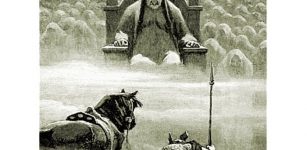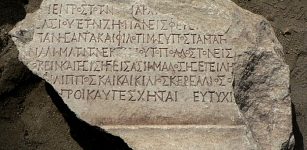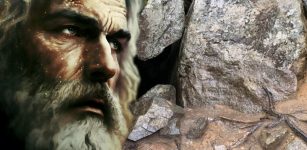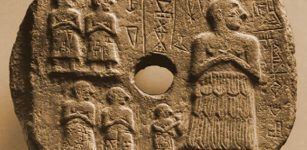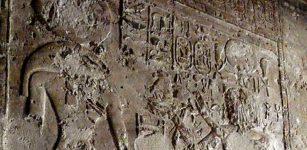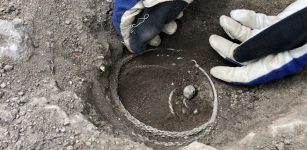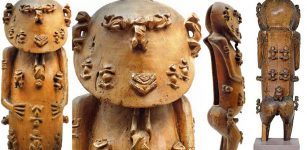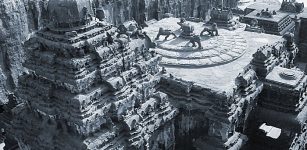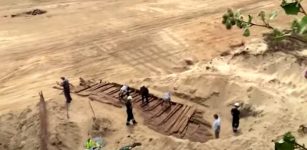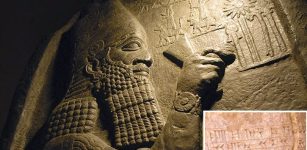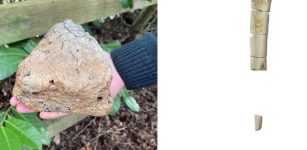3D Scans Reveal Thousands Of Never-Before-Seen Ancient American Rock Art Images In Alabama Cave
Jan Bartek - AncientPages.com - Since 1979, when the first cave art was documented in North America, dozens of other examples have come to light. Among these, the 19th Unnamed Cave in Alabama contains hundreds of pre-contact Native American mud glyph drawings.
An anthropomorph with a square head and two tapered lines extending from the top. The torso is rectangular, and the upper chest area has a series of short incisions with no clear pattern. (photograph by S. Alvarez; illustration by J. Simek).
Using high-resolution 3D photogrammetry, a technique that produces photorealistic digital models that can be manipulated in virtual space scientists have now discovered thousands of very large rock art images, which are amongst the largest known from North America.
The 19th Unnamed Cave in Alabama is known to scientists but its real name has been kept hidden to protect the artwork. The cavern comprises more than 5 km of underground passageways, and it the richest of all known cave art sites in south-eastern North America.
The mud glyph that emerged depicts a remarkable human figure facing the viewer. It has a long, well-formed body, with broad, rounded shoulders and extended arms. (photograph by S. Alvarez; illustration by J. Simek).
"First recognized to contain cave art in 1998, it contains hundreds of glyphs incised into the natural sediment coatings on the cave ceiling. The pictures cover an area of nearly 400m2 in varying densities, from single figures to palimpsests of extensively superimposed engravings.
While much of the imagery comprises abstract shapes and swirling lines, many representational figures are also worked into the sediment, including serpents, insects, birds, and anthropomorphism. Due to the low ceilings, most of these images, even though less than 1m in size, can only be viewed by lying on the cave floor. Thus, visibility of the cave art is constrained by the narrow confines of the cave itself, and the attenuated distance between the floor and ceiling limits perception of any larger images that might extend beyond the viewers’ field of vision.
Our results show how photogrammetry promises a new era of discovery of ancient cave art. The technique might also contribute to the discovery of many other unanticipated aspects of the archaeological record, for example architectural features," the scientists write in their paper published in the journal Antiquity.
Though it is impossible to date etchings made into walls, scientists have been able to date carbon left behind by torches carried by the artists. The results show the cave was created approximately 1,200 to 1,700 years ago. many of the cave drawings are remarkable.
One interesting mud mud glyph "depicts a remarkable human figure facing the viewer. It has a long, well-formed body, with broad, rounded shoulders and extended arms. A complex design covers the torso, comprising a few long, vertical lines connected along their lengths by numerous short, horizontal line segments. This design may represent garments or regalia, as the pattern extends from the shoulders to the bottom of the figure, and the legs are obscured by the patterned area.
Credit: Antiquity (2022). DOI: 10.15184/aqy.2022.24
Near the bottom of the anthropomorph, lines define a train or sash on the back of the figure, and parallel short line segments at the very base suggest a connection with the cave ceiling or, perhaps, symbolic emergence from the rock itself. The head is square with no facial features. Lines extending from the top of the head resemble feathers.
The figure holds in its left hand a round object—perhaps a rattle or weapon—and the figure's right hand connects to a natural, round depression in the cave ceiling, which is similar in size to the drawn circle in the opposite hand. Although this anthropomorph measures 1.81m in length, it cannot be seen in its entirety, even when lying flat on the cave floor.
Pre-contact cave art from the Southeast USA: a) petroglyphs of birds and weapons from 11th Unnamed Cave, Tennessee; b) mud glyph owl from Mud Glyph Cave, Tennessee; c) pictographs of canids from 48th Unnamed Cave, Tennessee (photographs by A. Cressler).
The science team spent two months photographing and documenting the ancient Native American cave art. This has not been an easy task as the 19th Unnamed Cave has very low ceilings. On many occasions, researchers had to lie on the ground to be able to see the artwork.
The use of photogrammetry made it possible to capture images that were invisible to the naked eye. In total, as many as 16,000 images were taken by researchers. Several of these are life-size images. The stunning cave art depicts scenes from daily life and animals such as fr example snakes.
Enigmatic figure of swirling lines, with a round head at one end and a possible rattlesnake tail at the other (2.12m wide) from 19th Unnamed Cave, Alabama (photograph by S. Alvarez; illustration by J. Simek).
"The most striking aspects of these cave art images are their size and context. Among the 19th Unnamed Cave mud glyphs are the largest cave art images known in North America. They are so large that the makers had to create the images without being able to see them in their entirety. Thus, the makers worked from their imaginations, rather than from an unimpeded visual perspective. These glyphs are similar in scale to the largest open-air rock art recorded in various contexts across the North American continent," the research team writes in their paper.
More information about this study can be read in the journal of Antiquity.
Written by Jan Bartek - AncientPages.com Staff Writer






